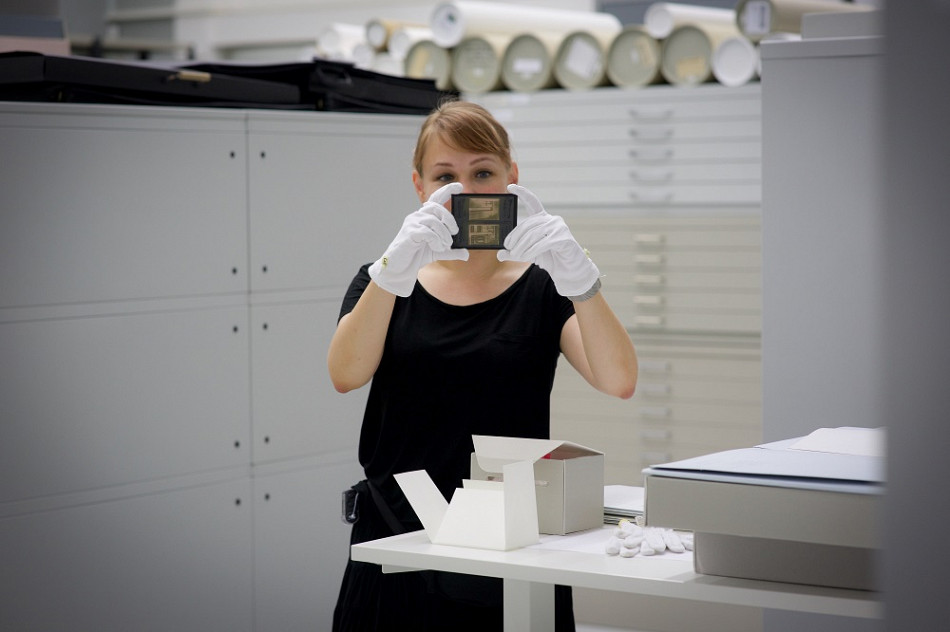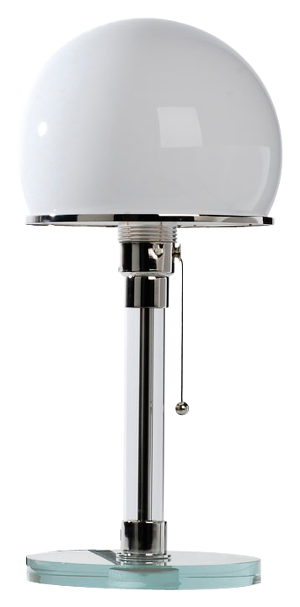
Nina Schönig
archivist
Nina, what are you working on at the moment?
We've just acquired a wonderful lot of photos by Kurt Kranz, who studied at the Bauhaus from 1930 to 1933 and earned his Bauhaus diploma in the advertising department. He photographed a lot for advertising, but he also documented life at the Bauhaus. There are almost sixty prints and another sixty or so negatives. I look at all of them, see if they are really vintage prints, that is, original prints from the 1920s and 1930s, or if they are reproductions that were possibly made much later by someone else entirely. I also try to identify who and what can be seen in the photo. Then my main task as an archivist is to name and record these objects so clearly that they can be found in the database as well as in the depot.
You are our the expert when it comes to our very large photo collection. Tell us a little bit about it!
The collection contains about 70,000 prints, and it is constantly growing. We have been collecting photographs since the early days of the Bauhaus-Archiv in the 1960s. These comprise photos from the Bauhaus period and afterwards, photos of works by Bauhäuslers, but also of the New Bauhaus and other successor institutions, portraits of people who were at the Bauhaus or had a connection to the Bauhaus, and quite a few private photos. For example, the travel albums of Gropius – Walter Gropius and his wife Ise traveled a lot and took just as many photos: in America, for example in the Grand Canyon, in England, in the former Yugoslavia. The collection also includes countless glass and film negatives as well slides, such as in Walter Gropius' large glass slide collection.
What are the core pieces of the collection?
Perhaps the most important collection – apart from Gropius' estate – is the photographic estate of Lucia Moholy. It alone comprises about 1,000 negatives. She documented life at the Bauhaus, but also Bauhaus products, especially the Bauhaus architecture in Dessau. These are the iconic photographs that are so well known today. But the collection also includes photos from her later life, she was an excellent portrait photographer. Lucia had to emigrate and continued to take an interest in the Bauhaus and its reception until her death at the age of more than ninety.
We also have a lot from T. Lux Feininger. He was only sixteen when he joined the Bauhaus, and was often present with his camera as a chronicler.
From Erich Consemüller we have beautiful object photos. Among these is the famous anonymous lady on the Breuer armchair, to which a chapter was dedicated in our centenary exhibition. And we have beautiful surreal still lifes from Walter Peterhans, who taught the first photography class at the Bauhaus when it was established in 1929.
Do you actually know what all Bauhäuslers looked like? The photo collection seems almost like a big family album of the Bauhaus.
I haven't been in charge of the photo collection for that long – but over the years you do get to know them all fairly well. If I don't recognise someone, I compare the pictures, put two photos next to each other. And you do build up some sort of personal relationship with the people in the photos as you immerse yourself in their lives. A few years ago, I handled the large estate of Gertrud Arndt - that's when I learned what the children looked like, what their names were, how old they were in the photos. And from that I was able to deduce when some of the photos might have been taken. In this way I also learned a lot about the private lives of many other Bauhäuslers.
Bauhaus photography is known for the spontaneity and lightness of many pictures. Were all these photos really snapshots?
That depended very much on the technical conditions. Gertrud Arndt, for example, still had a glass plate camera. So it was relatively complicated to take a photo. You had to put the plate in the camera in complete darkness. Because of the plates, the cameras were large and heavy and you often needed a tripod. It is all the more astonishing that Gertrud Arndt also used it to take snapshots of her children. But then, during the Bauhaus era, 35 mm photography came up, compact cameras like the Leica – quite a few Bauhaus people had a Leica - and that made photography much easier and faster. There was simply a roll of film in it instead of the fragile and heavy plates.
How can you surprise an archivist?
I am constantly surprised, actually. You never know exactly what to expect when a new acquisition arrives. It's always a bit like Christmas. There might be something completely unknown inside that will shed new light on Bauhaus research. Also you never know what condition the objects are in. Not all surprises are purely pleasant!
How do you imagine the archive of the future?
Digitalisation is a big issue right now. In my opinion, the ideal archive should be both analog and digital. The digital should not replace the analog, but support it, also in terms of worldwide and barrier-free accessibility. The ideal archive invites you in to discover its treasures. Such an open archive is not only exciting for international scholarschip, but for everyone. Anyone can look behind the scenes and make discoveries beyond what can be seen in the exhibition.
